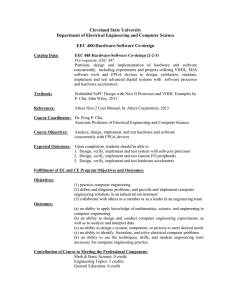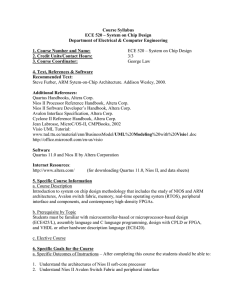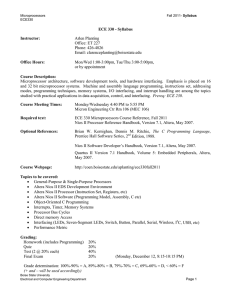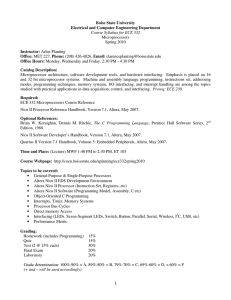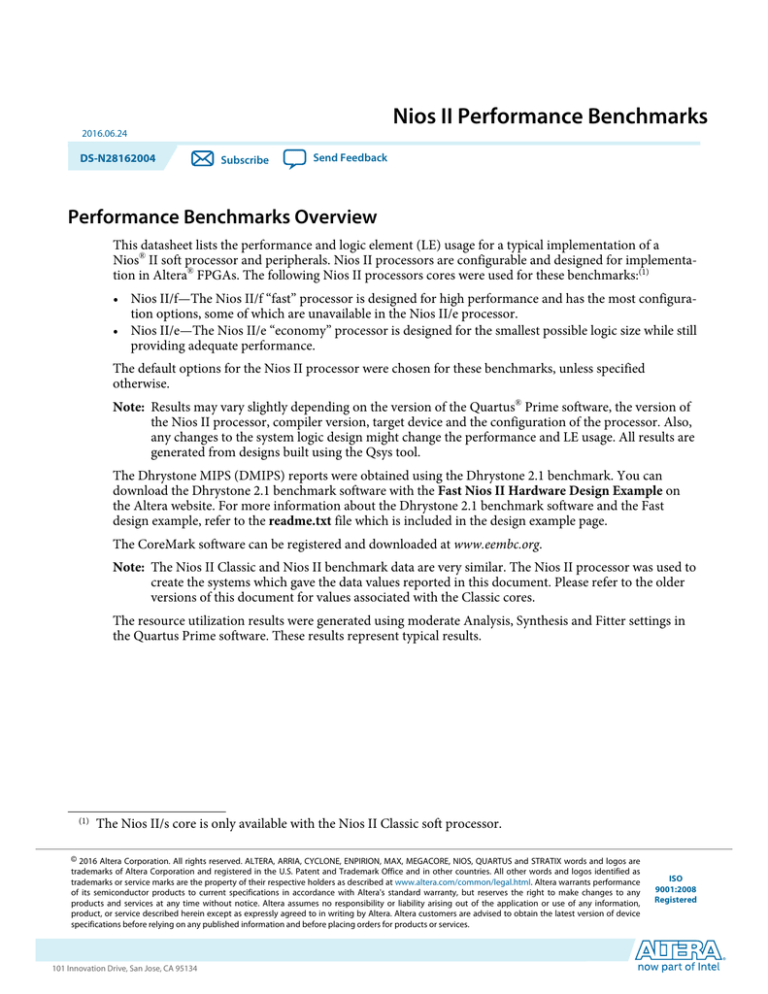
Nios II Performance Benchmarks
2016.06.24
DS-N28162004
Subscribe
Send Feedback
Performance Benchmarks Overview
This datasheet lists the performance and logic element (LE) usage for a typical implementation of a
Nios® II soft processor and peripherals. Nios II processors are configurable and designed for implementa‐
tion in Altera® FPGAs. The following Nios II processors cores were used for these benchmarks:(1)
• Nios II/f—The Nios II/f “fast” processor is designed for high performance and has the most configura‐
tion options, some of which are unavailable in the Nios II/e processor.
• Nios II/e—The Nios II/e “economy” processor is designed for the smallest possible logic size while still
providing adequate performance.
The default options for the Nios II processor were chosen for these benchmarks, unless specified
otherwise.
Note: Results may vary slightly depending on the version of the Quartus® Prime software, the version of
the Nios II processor, compiler version, target device and the configuration of the processor. Also,
any changes to the system logic design might change the performance and LE usage. All results are
generated from designs built using the Qsys tool.
The Dhrystone MIPS (DMIPS) reports were obtained using the Dhrystone 2.1 benchmark. You can
download the Dhrystone 2.1 benchmark software with the Fast Nios II Hardware Design Example on
the Altera website. For more information about the Dhrystone 2.1 benchmark software and the Fast
design example, refer to the readme.txt file which is included in the design example page.
The CoreMark software can be registered and downloaded at www.eembc.org.
Note: The Nios II Classic and Nios II benchmark data are very similar. The Nios II processor was used to
create the systems which gave the data values reported in this document. Please refer to the older
versions of this document for values associated with the Classic cores.
The resource utilization results were generated using moderate Analysis, Synthesis and Fitter settings in
the Quartus Prime software. These results represent typical results.
(1)
The Nios II/s core is only available with the Nios II Classic soft processor.
© 2016 Altera Corporation. All rights reserved. ALTERA, ARRIA, CYCLONE, ENPIRION, MAX, MEGACORE, NIOS, QUARTUS and STRATIX words and logos are
trademarks of Altera Corporation and registered in the U.S. Patent and Trademark Office and in other countries. All other words and logos identified as
trademarks or service marks are the property of their respective holders as described at www.altera.com/common/legal.html. Altera warrants performance
of its semiconductor products to current specifications in accordance with Altera's standard warranty, but reserves the right to make changes to any
products and services at any time without notice. Altera assumes no responsibility or liability arising out of the application or use of any information,
product, or service described herein except as expressly agreed to in writing by Altera. Altera customers are advised to obtain the latest version of device
specifications before relying on any published information and before placing orders for products or services.
www.altera.com
101 Innovation Drive, San Jose, CA 95134
ISO
9001:2008
Registered
2
DS-N28162004
2016.06.24
Performance Benchmarks Overview
Table 1: System Configuration for Nios II Performance Benchmarks
Benchmark
fmax
Nios II
Processor
I-Cache
D-Cache
Nios II/f
4 Kbytes
2 Kbytes
Nios II/e
Nios II/f
None
4 Kbytes
None
2 Kbytes
Other options
•
JTAG debug module
(default)
•
Hardware multiplier
•
•
•
Logic size
DMIPS
CoreMark(2)
JTAG debug module
(default)
JTAG debug module
(default)
Peripherals
•
64 Kbytes On-chip RAM
•
Avalon Memory-Mapped
pipeline Bridge
•
JTAG UART
•
Timer
•
64 Kbytes On-chip RAM
•
Avalon Memory-Mapped
pipeline Bridge
•
JTAG UART
•
Timer
•
64 Kbytes On-chip RAM
•
Avalon Memory-Mapped
pipeline Bridge
•
JTAG UART
•
Timer
•
Avalon UART
Hardware multiplier
•
Nios II/e
Nios II/f at
100 MHz
Nios II/f at
100 MHz
None
4 Kbytes
32 Kbytes
None
2 Kbytes
32 Kbytes
•
JTAG debug module
(default)
SDRAM controller(3)
•
64 Kbytes On-chip RAM
•
Avalon Memory-Mapped
pipeline Bridge
•
JTAG UART
•
Timer
•
Avalon UART
•
SDRAM controller(3)
•
JTAG debug module
(default)
•
128 Kbytes On-chip RAM
•
JTAG UART
•
Hardware multiplier
•
Timer
•
JTAG debug module
(default)
•
128 Kbytes On-chip RAM
•
JTAG UART
Hardware multiplier
•
Timer
•
Related Information
• Fast Nios II Hardware Design Example
• CoreMark Software Download
(2) This benchmark is compiled with the gcc -o3 switch for optimised performance.
(3)
The RAM controller for this device is based on DDR3 SDRAM Controller with UniPHY.
Altera Corporation
Nios II Performance Benchmarks
Send Feedback
DS-N28162004
2016.06.24
3
Nios II Performance Benchmarks
Nios II Performance Benchmarks
Table 2: fmax for Nios II Processor System (MHz)
Device Family
Device used
Nios II/f
Nios II/e
Stratix IV
EP4S100G5H40I1
240(4)
270(4)
Stratix V
5SGXEA7N2F45C1
350(4)
420(4)
Cyclone IV
EP4CGX30CF19C6
150(4)
170(4)
Cyclone V
5CGXFC7D6F31C6
170(4)
200(4)
Arria V GZ
5AGZME7K2F40C3
280(4)
360(4)
Arria V
5AGXFB5K4F40I3
200(4)
260(4)
Arria 10
10AX115U3F45I2LG
280(4)
330(4)
MAX 10
10M50DAF484C6GES
150(4)
170(4)
Table 3: Typical Logic Size for Nios II Processor Cores and Peripherals
Processor
Core /
Peripheral
Stratix IV
(ALUTs)
Stratix V
(ALMs)
Cyclone
IV GX
(ALUTs)
Cyclone Arria V GZ
V (ALMs)
(ALMs)
Arria V
(ALMs)
Arria 10
(ALMs)
MAX 10 (LE)
Nios II/f
1137
731
2266
846
743
865
847
2292
Nios II/e
527
292
770
307
293
304
289
799
Nios II
JTAG
debug
module
167
129
352
126
124
126
116
370
Avalon
UART
95
62
142
57
57
57
57
142
JTAG
UART
112
57
159
58
57
58
60
157
SDRAM
Controller
3809
2661
432
2466
2644
2461
184
4630
92
68
138
56
56
56
58
139
(3)
Timer
(4)
Results were generated using push button Analysis, Synthesis and Fitter settings in Quartus Prime.
Nios II Performance Benchmarks
Send Feedback
Altera Corporation
4
DS-N28162004
2016.06.24
Document Revision History
Table 4: Nios II Processor Architecture Performance
Performance Metric
DMIPS/MHz Ratio
CoreMark
Nios II/f
Nios II/e
0.9
0.1
193.3
16.8
Related Information
• AN-440: Accelerating Nios II Networking Applications
For more information about the Nios II networking applications performance.
• Nios II Custom Instruction User Guide
For more information about the Nios II floating-point custom instruction performance.
• Exception Handling
For more information about the Nios II interrupt latency performance, refer to the "Exception
Handling" chapter of the Nios II Software Developer's Handbook.
• AN730: Nios II Processor Booting Methods in MAX 10 FPGA Devices
For more information about the Nios II boot process and benchmarking.
Document Revision History
Data
Version
June 2016
2016.06.24
• Updated for 16.0 release
• Added Cylcone IV results
December 2015
2015.12.16
• Updated for 15.1 release
• Arria10 and CoreMark results added
Altera Corporation
Changes
Nios II Performance Benchmarks
Send Feedback


